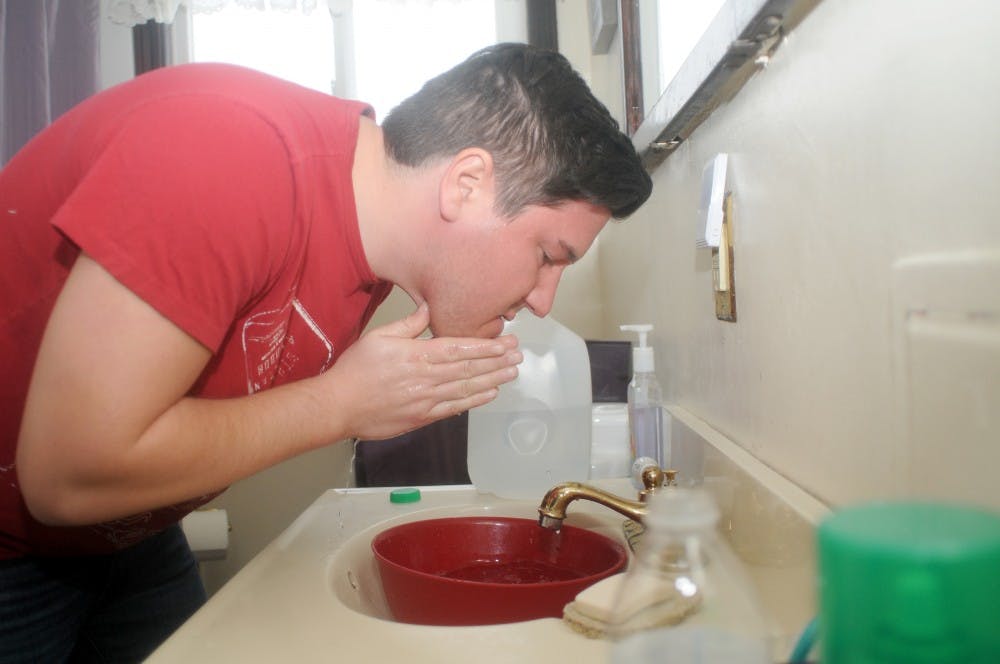The cup of water is clear as crystal. No noticeable odor, no odd coloration — it’s cool and crisp when it hits the tongue.
You would have no idea it is tainted with lead.
“Looks clean, doesn’t it?” Ricardo Vasquez said.
Vasquez, an interdisciplinary studies in social science senior, commutes to MSU four days out of the week. Although he used to live in apartment complexes closer to campus, he later found it cheaper and more convenient to drive to campus.
That was until the water in his and many other Flint residents’ homes became poisoned from lead and chlorine byproduct.
How it all started
Flint’s troubles began with a vote by its City Council back in March 2013. Instead of leasing the water from Detroit’s Water and Sewage Department as they had been doing, Flint’s leadership decided to get their water from a soon-to-be built pipeline known as the Karegnondi Water Authority.
With the pipeline still several years out from completion and no longer getting its water from Detroit, the city and its emergency manager at the time, Darnell Earley, resigned to using the Flint River as its main water source.
Efforts to clean up the polluted water began a snowball effect as problems continued to sprout, motivated largely in part by infrastructure problems. A chlorine-based water treatment created a corrosive effect within the city’s outdated lead pipes, leeching the toxic metal into the city’s water supply and slowly poisoning residents throughout a period of two years.
To the right of Vasquez’s kitchen sink is a shelf stacked with cases of bottled water and three filled pitchers, their own built-in filters attached.
“These are what they’re giving people, but now they’re saying there’s so much lead that the filters aren’t really doing anything,” he said.
The water in Vasquez’s home is still filled with lead toxins. Flint residents were given toothbrush-sized lead test kits meant to test the lead concentration of their water. There’s no “safe” levels of lead in drinking water, though the Environmental Protection Agency lists its “action level” as anything exceeding 15 parts per billion, or ppb.
When Vasquez inserted it into a glass of tap water, the result came up as 106 ppb.

Lives changed
Vasquez reshaped his daily routine to work around the contaminated water. Brushing his teeth requires a gallon of water to always be by the bathroom sink, which he also uses to wash his face. Before his family replaced the filter on their shower head, he was taking showers at the local Planet Fitness after driving home from MSU.
Even going out to eat presents its own challenges. Walking around Flint’s downtown, Vasquez pointed out all the restaurants boasting “SAFE WATER - LEAD TESTED” signs taped to the entrance doors.
This is the daily reality for many Flint residents. Mary Herman, a social relations and policy junior, attends MSU full time but frequently drives back to visit her family in Flint.
“It was really weird going home to always having to use the filtered water and we can’t use our ice cubes because that water doesn’t go through a filter,” Herman said. “It was also weird going out to eat in Flint. They’d give you a bottled water instead of just a glass.”
Standing in his sunlit kitchen on a particularly warm winter day, Vasquez might seem intimidating at first. Broad shouldered and thick armed, his size is betrayed by a boyish face and soft-tempered voice.
When he begins to reflect on the circumstances which led to the unsafe water in his home, his mood quickly changes. Suddenly, his physique matches the furor he has toward those who failed Flint.
“I’m pissed off because they’re lying to us,” Vasquez said. “They’re lying to people and you see kids breaking out in rashes. They have to get poked just to see if they’re OK.”
The cost of water
His ire is what drew Vasquez to his first engagement with activism. During Gov. Rick Snyder’s State of the State Address, hundreds of Michiganians flocked to the Capitol steps to protest Snyder and his administration’s lethargic response to the crisis in the two years it formed.
Among the crowd was Vasquez, holding up a United Auto Workers, or UAW, sign and chanting along with the protesters. His cousin, Dan Reyes, is head of the UAW-Flint chapter.

Like many of the residents in Flint, Vasquez and his family first came to the city seeking employment opportunities from the bustling automotive industry there. Moving up from Texas in the 1950s, Vasquez’s grandfather and his son, Richard, found a steady job working for General Motors, or GM.
Along with a job and pay, GM would also help house many of its employees, creating entire neighborhoods of GM workers. Vasquez’s house resides in one such neighborhood.
From the outside everything looks quaint and comfortably middle class. One could transplant the entire street Vasquez lives on and place it in Ferndale without much noticeably changing. Except, of course, the fact that his house value has gone down considerably since the water crisis began.
When his father first bought the house, it was worth about $70,000. Now it’s barely hovering at approximately $10,000.
While property values have rapidly decreased, the cost of water has only gone up. Vasquez’s family pays approximately $150 a month. The Flint Journal estimated in 2014 the average cost to be around $140 per month, roughly eight times the national average, according to an article from NPR.v
“We’re paying more than people in San Francisco, you know, or New York City,” Vasquez said.
Distributing water
Stockpiling water has now become a necessity for many residents. Flint has been lucky enough to receive an outpouring of support, which usually manifests as hundreds of cases of bottled water arriving at the city’s many fire stations, schools and churches.
At the church Vasquez’s family attends, Our Lady of Guadalupe Catholic Church, the building’s main foyer is lined with stacks of bottled water, filters and pitchers. Children run around playing tag and hiding in between the towers of water. The scent of cooked ground beef and paprika comes from the taco bar in the back, open to all who enter.
Our Lady of Guadalupe got involved after parish member Richard Vasquez, Ricardo’s father, took it upon himself to assist undocumented workers that needed water, since official water distribution sites have previously turned them away since they can’t prove residency.
Unlike other distribution sites, Our Lady of Guadalupe functions on an honor system. People come and go and request what they need.
If they can’t provide proof of residence, Vasquez just marks their name down on a white slip of paper and helps carry the water to their car.
The church’s deacon, Omar Odette, who functions as a type of administrator, contrasted the sense of communal trust to the disdain many Flint residents have for the powers that be who are involved in the crisis.
“A lot of us aren’t trusting what we’re being told at times because, you know, for a long time they told us the water was fine,” Odette said. “It’s going to take a long time to build that trust back up.”
The perception of Flint
That sense of manipulation is felt strongly by Vasquez, who said he felt marginalized by the political insincerity and the descent of the media to the Rust Belt city.
“They’re making Flint seem like we’re this poor community that doesn’t have grocery stores or everyone’s poor here. ... The media, they don’t live here, so they don’t know exactly what life’s like down here,” Vasquez said.
Across the pond in Europe, the story surrounding Flint is the same kind of doom-and-gloom coverage. Michael Allard, a former Flint resident and MSU alumnus studying at the University of Edinburgh in Scotland, has talked with many people there about Flint.
“People know where you are from now, so you talk about the city through the crisis,” Allard said. “The hardest thing is trying to change their imagination. People have seen ‘Roger and Me.’ They have seen that it’s like America’s most dangerous city. And now there’s a water crisis.”
The movie he refers to, “Roger and Me,” was a documentary released in 1989 by filmmaker Michael Moore, himself a native of Flint. While critically accepted, the film firmly planted in the minds of its viewers an image of a city in decline and continually getting worse.
“The tales are mostly of aid,” Allard said. “Like it’s a Third World city now — America’s exception to the First World.”
Vasquez said he sees the perception as a detriment.
“All this is going to do is set Flint back because Flint was on a comeback,” Vasquez said.
It might seem strange to outsiders, but Flint’s residents almost balk at the idea of leaving the city, fully aware of all its faults.
“Not a lot of people are just going to pick up and move out of Flint,” Vasquez said. “You know this is home, no matter how bad the rep we get or how bad it is, people don’t want to move.”







